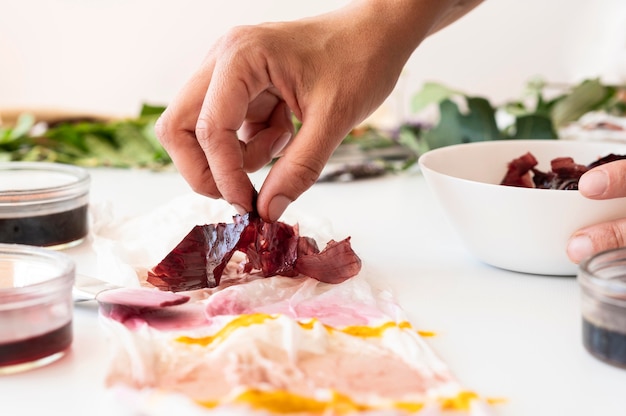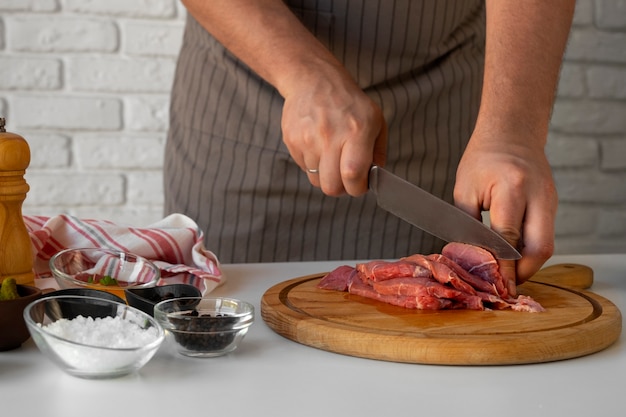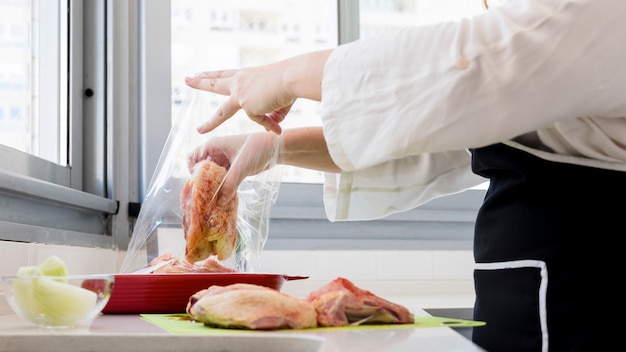Ham 101: Understanding the Types

First things first, you need to understand the type of ham you're working with. Ham comes in a variety of forms, each with its own unique characteristics and cooking requirements. You've got your bone-in, your boneless, your spiral-cut, your pre-cooked… the list goes on! Knowing the differences is essential to getting the perfect cook.
Bone-In: The Classic Choice
bone-in hams are, as the name suggests, hams that still have the bone intact. This gives them a classic, traditional feel and a unique flavour, as the bone helps distribute heat evenly. But it also means they'll take longer to cook than their boneless counterparts. The bone acts like a natural heat reservoir, ensuring a more even cook and a tender, juicy result.
Boneless: Easy and Convenient
boneless hams, as you might expect, are simply hams that have been deboned for convenience and easier slicing. They cook faster than bone-in hams because heat can penetrate the meat more quickly. This makes them a great option for busy cooks or those looking for a less time-intensive preparation.
Spiral-Cut: A Time-Saver
Spiral-cut hams are pre-sliced and often have a glaze already applied. This makes them incredibly convenient, as they require less prep and cook much faster than whole hams. The spiral cuts allow for faster cooking because the heat can reach all parts of the ham more easily. They are an ideal choice for a quick meal or for those who want a beautiful presentation without the fuss.
Pre-Cooked: Ready to Eat (or Reheat!)
pre-cooked ham is already fully cooked, so it only needs to be warmed up. This means it takes just a fraction of the time to prepare, making it perfect for a last-minute meal or for a simple weeknight dinner. You can pop it in the oven, on the stove, or even in the microwave for a quick and delicious meal. Just remember to heat it thoroughly for safety.
(Part 2)Decoding the Ham Cooking Time Chart

Now that you understand the different types of ham, let's talk about those cook times. You'll find general guidelines on the packaging, but for more precise cooking, you need a handy-dandy chart. But it's not as simple as a one-size-fits-all approach. Each type of ham has its own specific cooking requirements.
Finding the Right Chart
There are many ham cooking time charts available online and in cookbooks. However, it's essential to find a chart specifically designed for the type of ham you're using. A chart for bone-in ham will differ significantly from a chart for boneless ham, and so on.
General Ham Cooking Time Chart (per pound)
This chart offers a good starting point, but remember, it's just a guideline. Always use a meat thermometer to confirm the ham has reached the safe internal temperature of 145°F (63°C).
| Type of Ham | Cooking Time per Pound |
|---|---|
| Bone-in (uncooked) | 18-20 minutes |
| Boneless (uncooked) | 15-18 minutes |
| Spiral-Cut (pre-cooked) | 10-15 minutes |
| Pre-Cooked (whole) | 5-10 minutes per pound |
Temperature is Key: Using a Meat Thermometer
The most important thing when cooking ham is to ensure it reaches a safe internal temperature. A meat thermometer is your best friend in this process. Insert the thermometer into the thickest part of the ham, making sure not to touch the bone. For both pre-cooked and uncooked hams, you want to reach 145°F (63°C). For pre-cooked ham, this temperature ensures it's thoroughly warmed through.
(Part 3)The Art of Ham Cooking: Methods and Techniques

Once you know the type of ham and the cooking time, it's time to choose your cooking method. There are a variety of ways to cook ham, each with its own unique flavour profile and texture. Whether you prefer the classic oven roast, the smoky grill, or the slow and steady slow cooker, there's a method to match your preferences.
oven roasting: The Classic Approach
Oven roasting is the tried-and-true method for cooking ham. It's simple, reliable, and produces a juicy, flavourful ham. Preheat your oven to 325°F (165°C) and place the ham in a roasting pan. Add some water to the bottom of the pan to keep the ham moist, and consider adding your favourite glaze for added flavour and colour.
Grilling: For a Smoky, Outdoor Flavour
Grilling ham is a delicious way to add a smoky touch to the meat. It's best to use boneless or spiral-cut ham for grilling, as these shapes cook more evenly. Preheat your grill to medium-high heat and cook the ham for about 10-15 minutes per pound. For extra flavour, brush the ham with a glaze or marinade while grilling.
slow cooking: The Ultimate Tenderizer
Slow cooking is a fantastic option for achieving a tender, juicy ham, especially for bone-in hams. The low and slow heat breaks down the tough connective tissues, resulting in a melt-in-your-mouth texture. Simply place the ham in your slow cooker, add some liquid for moisture, and let it cook for several hours on low heat.
(Part 4)The Glaze: The Finishing Touch
A good ham glaze is the cherry on top of a delicious ham. It adds sweetness, colour, and a beautiful shine. There are countless glaze variations, but here are a few popular classics to inspire you.
Glaze Recipes to Make Your Ham Shine
- Brown Sugar and Maple Syrup Glaze: This classic glaze is sweet and sticky, with a rich maple flavour. Simply combine brown sugar, maple syrup, and a touch of mustard for a delicious combination.
- honey mustard glaze: This glaze offers a tangy sweetness with a hint of spice. Mix honey, Dijon mustard, and a pinch of paprika for a flavourful glaze.
- Pineapple and brown sugar glaze: This tropical glaze is perfect for adding a touch of sweetness and a vibrant flavour. Combine pineapple juice, brown sugar, and a dash of cinnamon for a delightful glaze.
- cherry glaze: This sweet and tart glaze is perfect for a festive touch. Combine cherry preserves, brown sugar, and a splash of red wine vinegar for a delicious and vibrant glaze.
Glazing Tips for Perfection
Here are some tips for glazing your ham to perfection:
- Apply the glaze in the last 30 minutes of cooking. This allows the glaze to caramelize and create a beautiful, crispy crust.
- Use a basting brush to evenly spread the glaze. This ensures a consistent coating and a beautiful, even glaze.
- If you want a thicker glaze, reduce it over low heat for a few minutes before adding it to the ham. This creates a richer, more concentrated flavour and a thicker, more decadent glaze.
Storing and Serving Your Culinary Masterpiece
Once your ham is cooked, you need to store it properly to preserve its deliciousness. Leftovers can be kept in the refrigerator for up to 3-4 days, or you can freeze them for up to 2-3 months. When freezing, wrap the ham tightly in plastic wrap and aluminum foil to prevent freezer burn.
FAQs
1. How do I know if my ham is fully cooked?
The best way to ensure your ham is cooked thoroughly is by using a meat thermometer. Insert it into the thickest part of the ham, making sure it doesn’t touch bone. The internal temperature should reach 145°F (63°C) for safety.
2. Can I cook a ham in a pressure cooker?
You can, but be cautious. Pressure cookers can cook ham quickly, but it's essential to adjust cooking times based on the size and type of ham you're using. Consult your pressure cooker manual for specific instructions and recommendations.
3. Can I use a pre-cooked ham for a traditional ham dinner?
Absolutely! Pre-cooked hams can be heated in the oven and glazed just like any other ham. They're a great shortcut for busy schedules or if you're short on time.
4. Can I use leftover ham in other dishes?
Definitely! Leftover ham is incredibly versatile and delicious in a variety of dishes. It adds flavour to sandwiches, salads, soups, and even breakfast dishes like quiche. Get creative and explore the endless possibilities.
5. How do I choose the best ham for my needs?
Consider the size, type (bone-in or boneless), and cooking method you prefer. If you want a quick and easy option, choose a pre-cooked spiral-cut ham. For a traditional ham roast, a bone-in ham is a classic choice. Ultimately, the best ham is the one that fits your preferences and your cooking style.
There you have it! With these tips and tricks, you'll be a ham-cooking pro in no time. So, go forth and create your own culinary masterpiece. Your family and friends will be thanking you for it!
Everyone is watching

Corn on the Cob: The Ultimate Guide to Perfectly Cooked Ears
Healthy MealsAh, corn on the cob. Just the name evokes images of sunny days, barbecues, and that sweet, juicy flavour that ...

Perfect Pork Roast Oven Cooking Time: A Guide to Delicious Results
Healthy MealsThere's something truly satisfying about a perfectly roasted pork. The aroma alone is enough to make your mout...

Scallops: The Ultimate Guide to Perfect Cooking
Healthy MealsAh, scallops. Those delicate, sweet, and utterly delicious morsels of the sea. They hold a special place in my...

Spaghetti Squash: The Ultimate Guide to Cooking and Serving
Healthy MealsRemember that time you saw spaghetti squash at the supermarket, looking all bumpy and strange, and thought, "W...

Ham Cooking Time: How Long to Bake, Smoke, or Boil a Delicious Ham
Healthy MealsAh, ham. It's a classic, isn't it? A real crowd-pleaser, especially around holidays. And when done right, it'...
